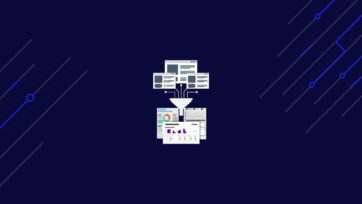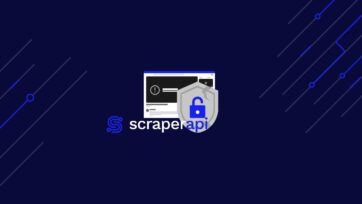Ever tried scraping data only to hit a wall with tools like DataDome blocking your every move? It’s frustrating, right? But don’t worry—there’s a way to overcome these obstacles.
In this article, I’ll walk you through:
- What DataDome is and how it works
- How to use Python and ScraperAPI to bypass DataDome protected websites
- Alternative methods you can use to bypass DataDome if you’re looking for different approaches
TL;DR: Bypassing DataDome Protected Sites [Easiest Approach]
To bypass DataDome consistently and at scale, the best approach is to use ScraperAPI to send your requests.
ScraperAPI will handle CAPTCHA challenges, IP rotation, headers and cookies generating and matching, and more, keeping your scrapers running without complicated setups. Just a simple API call:
</p>
import requests
from bs4 import BeautifulSoup
payload = {
'api_key': 'YOUR_API_KEY',
'url': 'datadome_protected_URL',
'render': 'true', #if this doesn't work, try enabling ultra_premium proxies without render
#'ultra_premium': 'true'
}
response = requests.get('https://api.scraperapi.com', params=payload)
soup = BeautifulSoup(response.text, 'html.parser')
if response.status_code == 200:
print("Successfully bypassed DataDome!")
soup = BeautifulSoup(response.text, 'html.parser')
print(soup.text)
else:
print(f"Failed to bypass DataDome. Status code: {response.status_code}")
<p>DataDome is constantly updating its defenses, so your scrapers and solutions must adapt fast enough to keep data flowing.
ScraperAPI’s team is continuously working to improve success rates and bypass DataDome blockers.
To get started, create a free ScraperAPI account and replace the placeholders in the api_key and url variables within the payload.
ScraperAPI’s advanced anti-bot bypassing allows you to scrape DataDome-protected sites without getting blocked.
So, what exactly are you up against with DataDome? Let’s break it down.
What is DataDome?
DataDome is a sophisticated bot protection service that detects and blocks automated web scraping activities. It’s like a bouncer at the door, using a combination of advanced machine learning algorithms, behavioral analysis, and real-time data processing to distinguish between legitimate human users and bots.
Understanding How DataDome Works
Here’s a breakdown of how DataDome works:
1. Behavioral Analysis
DataDome closely monitors user behavior in real-time, analyzing patterns such as mouse movements, clicks, and scrolling to identify bots. If your behavior doesn’t match typical human patterns, DataDome might flag you as a bot.
Mimicking human behavior is essential to avoid detection. Tools like Selenium, Puppeteer, or Playwright are great for simulating realistic user interactions, but ScraperAPI enhances this by managing request pacing and traffic distribution, making your bot’s behavior appear more legitimate with minimal manual intervention.
2. Device and Browser Fingerprinting
DataDome collects detailed information about your device, including browser characteristics, IP address, and operating system, to create a unique fingerprint for each visitor. This fingerprint helps track potential bots across sessions.
To avoid being flagged, it’s essential to frequently change your scraper’s fingerprint by randomizing user-agent strings, spoofing browser data, and using headless browsers that are harder to detect.
ScraperAPI simplifies this by automatically rotating user agents and headers, ensuring your scraper blends in with regular traffic.
For those looking for more control, integrating tools like Selenium Stealth, Puppeteer Extra Plugin Stealth, and Playwright Stealth can offer advanced fingerprinting solutions that work seamlessly with ScraperAPI’s automated processes.
3. Real-Time IP Analysis
DataDome maintains a comprehensive database of known malicious IP addresses. If your request comes from a suspicious IP, it can be blocked instantly.
To counter this, it’s crucial to use high-quality residential or mobile proxies from trusted providers, which resemble regular home users and are less likely to be flagged.
ScraperAPI excels here by offering built-in IP rotation with a pool of reputable residential and private mobile IPs, reducing the likelihood of detection. This automatic IP rotation ensures that your requests originate from diverse, trustworthy sources, helping you maintain uninterrupted access.
4. CAPTCHA and JavaScript Challenges
When DataDome suspects bot activity, it may deploy CAPTCHAs or complex JavaScript challenges to verify if the user is human. Bots that fail these tests are blocked from accessing the site.
While integrating CAPTCHA-solving services like 2Captcha, Anti-Captcha, and DeathByCaptcha is one way to handle these challenges, ScraperAPI makes it easier by automatically managing CAPTCHA challenges. This allows your scraper to continue its tasks without being bogged down by interruptions.
Additionally, by adopting more human-like interaction patterns and reducing the frequency of requests, your scraper can lower the likelihood of triggering these challenges, making ScraperAPI an all-in-one solution for both scraping and CAPTCHA management.
How to Bypass DataDome’s Anti-Bot Measures
With a clear understanding of how DataDome works, let’s explore strategies for bypassing its sophisticated defenses. DataDome’s multiple layers of protection make it one of the most challenging systems to overcome, but with the right approach and tools, you can successfully navigate these barriers.
1. Use ScraperAPI to Bypass DataDome’s Challenges
ScraperAPI automates many tasks that would otherwise take up much of your time, such as IP rotation, user-agent management, and CAPTCHA handling.
Think of ScraperAPI as your Swiss Army knife for scraping—compact, versatile, and ready to tackle whatever DataDome throws your way.
How It Works:
ScraperAPI handles everything behind the scenes—rotating IPs, managing headers, and even dealing with CAPTCHAs—so you don’t have to worry about the details. All you need to do is make a simple API call.
Here’s how you can use it to scrape a DataDome-protected site like LeBonCoin:
-
Sign up for ScraperAPI: First, create an account on
ScraperAPI’s website
to get your API key.
- Attempt to scrape without ScraperAPI: Let’s try to scrape LeBonCoin, a site protected by DataDome, without using ScraperAP:
import requests
URL = 'https://www.leboncoin.fr/'
response = requests.get(URL)
print(response.text)
When you run this script, instead of retrieving the HTML content of the page, you’ll likely receive a response that redirects you to a CAPTCHA or a block page.
The output will include an error message or a challenge that requires human interaction—DataDome’s way of preventing automated access.
- Set up your request using ScraperAPI: Now, let’s see how ScraperAPI can help you bypass these defenses. Here’s how you can modify your script to use ScraperAPI:
import requests
from bs4 import BeautifulSoup
API_KEY = 'YOUR_SCRAPER_API_KEY'
URL = 'https://www.leboncoin.fr/'
params = {
'api_key': API_KEY,
'url': URL,
'render': 'true' # Ensures that JavaScript is rendered, which is crucial for DataDome-protected sites
}
response = requests.get('https://api.scraperapi.com', params=params)
if response.status_code == 200:
print("Successfully bypassed DataDome!")
soup = BeautifulSoup(response.text, 'html.parser')
print(soup.text) # This will now contain the actual HTML of the LeBonCoin homepage
else:
print(f"Failed to bypass DataDome. Status code: {response.status_code}")
Pros:
- Automatically handles IP rotation, user-agent management, and CAPTCHA challenges.
- Easy to integrate into your existing Python scripts.
- Provides consistent, reliable scraping without the hassle of manual setup.
Cons:
- Requires a subscription (though it’s worth it for the time and headaches it saves).
2. Mimicking Human Behavior
As DataDome relies heavily on behavioral analysis to detect bots, your bot needs to replicate human behavior with precision. This includes randomizing delays, varying scrolling speeds, and introducing natural mouse movements.
Advanced browser automation tools like Selenium, Puppeteer, and Playwright, paired with ScraperAPI’s request pacing and traffic distribution features, can help your bot behave in ways that closely mimic human users, reducing the risk of detection.
Using Headless Browsers with Selenium
Headless browsers can be a lifesaver if you’re dealing with sites that rely heavily on JavaScript. Using tools like Selenium, you can mimic human browsing behavior, which can help you bypass some of DataDome’s defenses.
How It Works:
You use Selenium to launch a headless browser (a browser without a user interface) that can interact with the web like a real user. This allows you to execute JavaScript and interact with page elements, which is often necessary for DataDome-protected sites.
Here’s a basic setup:
from selenium import webdriver
options = webdriver.ChromeOptions()
options.add_argument('headless')
driver = webdriver.Chrome(options=options)
driver.get('https://www.leboncoin.fr/')
print(driver.page_source)
driver.quit()
Pros:
- Capable of handling complex JavaScript-rendered pages.
- It can bypass some detection mechanisms that rely on checking for real user interactions.
Cons:
- Resource-intensive and slower compared to other methods.
- It may still get blocked by advanced systems like DataDome if not combined with other techniques.
3. Using Advanced Residential Proxies
DataDome’s real-time IP reputation analysis blocks requests from flagged IP addresses. To maintain access, use high-quality residential and mobile proxies from trusted providers, which are less likely to be detected.
Here’s a list of reputable proxy providers for scraping tough sites you could try.
Manual Proxy Rotation
This involves setting up a pool of IP addresses and switching between them with each request. The idea is to distribute your requests across multiple IPs, making it harder for DataDome to detect and block your scraping activities.
How It Works:
You maintain a list of proxy IPs (or buy it from a provider) and configure your scraper to rotate through them. Each request is sent from a different IP, reducing the likelihood of being flagged.
Here’s a quick example using Python:
import requests
proxies = {
'http': 'http://your_proxy:port',
'https': 'https://your_proxy:port'
}
response = requests.get('https://www.leboncoin.fr/', proxies=proxies)
Pros:
- Gives you control over the proxy rotation.
- It can be effective if the proxies are of high quality.
Cons:
- Requires a reliable source of proxies.
- Time-consuming to manage and monitor.
- Less effective if proxies are detected or blocked by DataDome.
4. Spoofing Device and Browser Fingerprints
To bypass DataDome’s device and browser fingerprinting, it’s important to regularly alter your scraper’s fingerprint by rotating user-agent strings and spoofing browser data.
Tools like Selenium Stealth, Puppeteer Extra Plugin Stealth, and Playwright Stealth allow for advanced fingerprint manipulation. When combined with ScraperAPI’s automatic rotation of user agents and headers, this makes it much harder for DataDome to track and flag your bot.
Custom User-Agent Rotation
Another technique is rotating user agents. The user-agent string identifies your browser and device type, and by changing it for each request, you can reduce the chances of your scraper being flagged as a bot.
How It Works:
You maintain a list of user-agent strings and randomly select one for each request. This helps make your scraping activities appear more like real user browsing.
Here’s how you can do it:
import random
import requests
user_agents = [
'Mozilla/5.0 (Windows NT 10.0; Win64; x64)',
'Mozilla/5.0 (Macintosh; Intel Mac OS X 10_15_7)',
# Add more user agents
]
headers = {
'User-Agent': random.choice(user_agents)
}
response = requests.get('https://www.leboncoin.fr/', headers=headers)
Pros:
- It helps avoid detection by making your requests appear more diverse.
- Simple to implement and combine with other methods.
Cons:
- It’s not a standalone solution—it needs to be combined with other techniques like proxy rotation for better effectiveness.
- Limited impact against advanced detection systems like DataDome.
4. Handling CAPTCHAs and JavaScript Challenges
DataDome uses CAPTCHAs and JavaScript challenges to weed out bots. By integrating CAPTCHA-solving services or, more effectively, using ScraperAPI’s built-in CAPTCHA management, you can navigate these hurdles without slowing down your scraping operations.
Additionally, ensuring that your bot can execute JavaScript fully and pass browser integrity checks will further help you avoid detection and maintain continuous access.
You can accomplish this by using a headless browser or enabling
render=true when using ScraperAPI to render the page.
5. Diversifying Traffic Patterns
DataDome’s machine learning algorithms are designed to detect patterns in traffic that suggest bot activity. To stay undetected, it’s crucial to diversify your traffic by rotating IP addresses, user agents, and request intervals and by simulating human-like sessions with cookies.
ScraperAPI uses machine learning and years of statistical analysis to choose the right IP address and generate matching headers and cookies to guarantee a successful request. Thus, your bot’s traffic is indistinguishable from legitimate user traffic.
Wrapping Up: Why Choose ScraperAPI to Bypass DataDome?
Plenty of scraping tools are out there, so you might be wondering—what makes ScraperAPI the best choice for bypassing DataDome? Here’s why:
1. All-In-One Solution
ScraperAPI is more than just a proxy service. It combines IP rotation, user-agent management, and CAPTCHA solving in one package, making it a comprehensive solution for dealing with sophisticated anti-scraping tools like DataDome. You don’t have to worry about piecing together different tools to get the job done—ScraperAPI handles it all.
2. Ease of Use
Integrating ScraperAPI into your existing Python scripts is straightforward. With just a few lines of code, you can start scraping even the most protected sites. This ease of use saves you time and effort, allowing you to focus on analyzing the data rather than battling anti-scraping measures.
3. Reliability
ScraperAPI is built to be reliable. Whether you’re scraping a few pages or handling large-scale scraping operations, ScraperAPI provides consistent performance. You won’t have to deal with constant blocks or errors, which means less downtime and more productivity.
4. Scalability
As your scraping needs grow, ScraperAPI scales with you. Whether you’re working on a small project or a large enterprise-level scraping operation, ScraperAPI can handle the workload without compromising on speed or reliability.
5. Support and Resources
When you choose ScraperAPI, you’re not just getting a tool—you’re gaining access to a wealth of support and resources. ScraperAPI offers comprehensive documentation, tutorials, and responsive customer support to help you overcome any challenges you might face.




